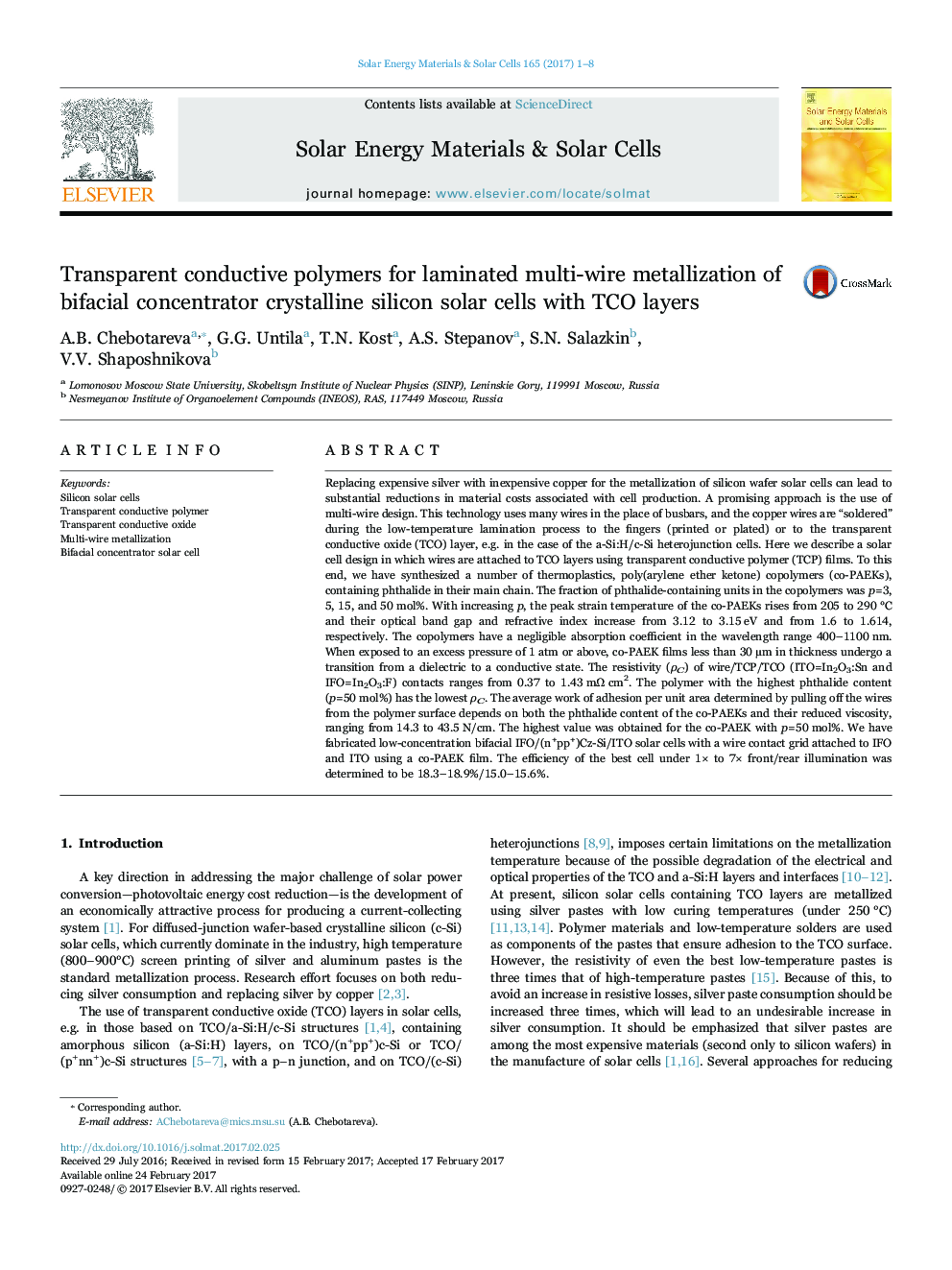| Article ID | Journal | Published Year | Pages | File Type |
|---|---|---|---|---|
| 6457132 | Solar Energy Materials and Solar Cells | 2017 | 8 Pages |
â¢Wire grid was attached to TCO layers in solar cell using TCP films (co-PAEKs).â¢Co-PAEKs had a negligible absorption coefficient in the range 400-1100 nm.â¢The best resistivity of wire/TCP/TCO contact was about 0.37 mΩ cm2.â¢Low-concentration bifacial IFO/(n+pp+)Cz-Si/ITO solar cells were fabricated.â¢Front/rear efficiencies of 18.3-18.9%/15.0-15.6% were achieved under 1à to 7Ã.
Replacing expensive silver with inexpensive copper for the metallization of silicon wafer solar cells can lead to substantial reductions in material costs associated with cell production. A promising approach is the use of multi-wire design. This technology uses many wires in the place of busbars, and the copper wires are “soldered” during the low-temperature lamination process to the fingers (printed or plated) or to the transparent conductive oxide (TCO) layer, e.g. in the case of the a-Si:H/c-Si heterojunction cells. Here we describe a solar cell design in which wires are attached to TCO layers using transparent conductive polymer (TCP) films. To this end, we have synthesized a number of thermoplastics, poly(arylene ether ketone) copolymers (co-PAEKs), containing phthalide in their main chain. The fraction of phthalide-containing units in the copolymers was p=3, 5, 15, and 50 mol%. With increasing p, the peak strain temperature of the co-PAEKs rises from 205 to 290 °C and their optical band gap and refractive index increase from 3.12 to 3.15 eV and from 1.6 to 1.614, respectively. The copolymers have a negligible absorption coefficient in the wavelength range 400-1100 nm. When exposed to an excess pressure of 1 atm or above, co-PAEK films less than 30 µm in thickness undergo a transition from a dielectric to a conductive state. The resistivity (ÏС) of wire/TCP/TCO (ITO=In2O3:Sn and IFO=In2O3:F) contacts ranges from 0.37 to 1.43 mΩ cm2. The polymer with the highest phthalide content (p=50 mol%) has the lowest ÏС. The average work of adhesion per unit area determined by pulling off the wires from the polymer surface depends on both the phthalide content of the co-PAEKs and their reduced viscosity, ranging from 14.3 to 43.5 N/cm. The highest value was obtained for the co-PAEK with p=50 mol%. We have fabricated low-concentration bifacial IFO/(n+pp+)Cz-Si/ITO solar cells with a wire contact grid attached to IFO and ITO using a co-PAEK film. The efficiency of the best cell under 1à to 7à front/rear illumination was determined to be 18.3-18.9%/15.0-15.6%.
Graphical abstractSchematic of a bifacial concentrator TCP-containing Laminated Grid silicon solar cell: sections (a) along and (b) across the wires. The cell in picture a) is not encapsulated.Download high-res image (236KB)Download full-size image
